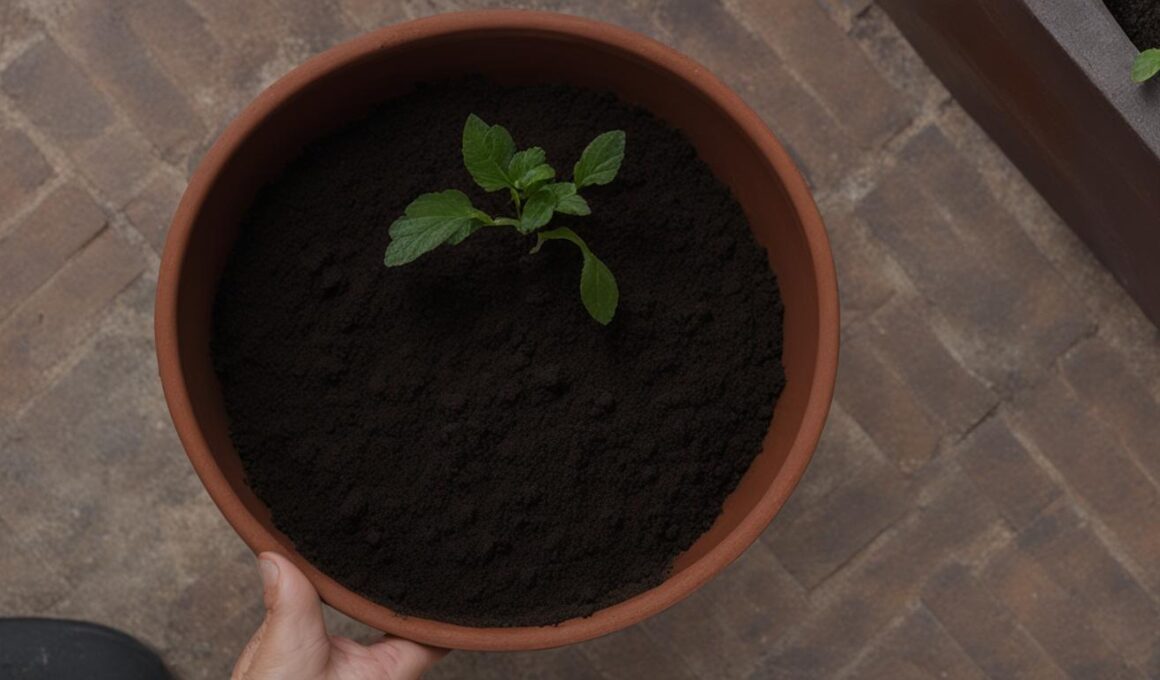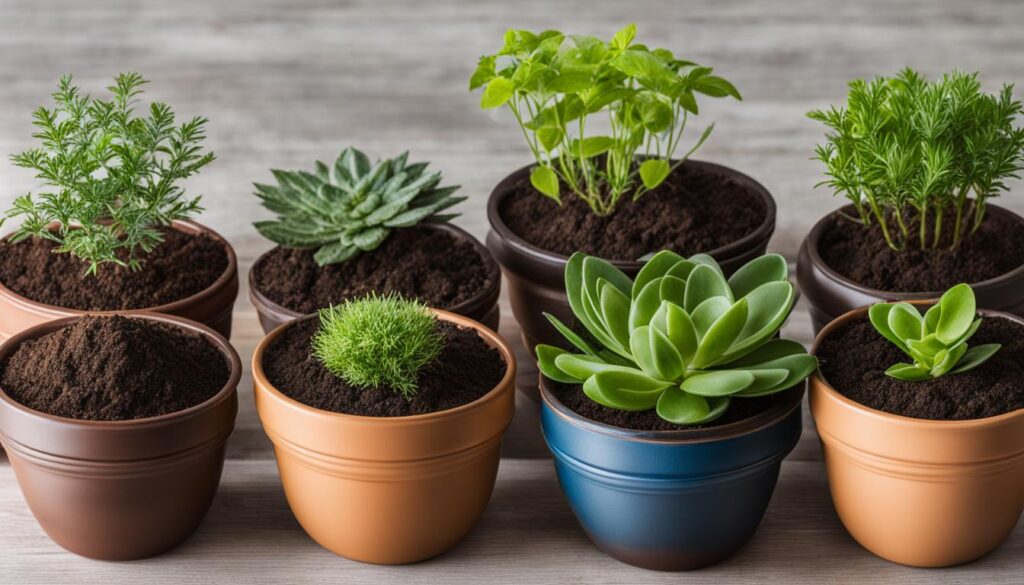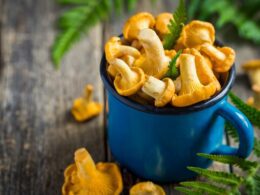When it comes to potting plants, knowing how much soil is needed for each container is crucial. In this article, we will focus on the specific requirements for a 6 inch pot. Understanding the right amount of soil will help you create optimal growing conditions for your plants and ensure their healthy development.
Key Takeaways:
- For a 6 inch pot, approximately 1 quart or 0.03 cubic feet of dry soil is typically required.
- Consider soil compression, which can add an additional 15-20% of dry soil to the pot.
- Transplanting plants may also affect the amount of soil needed.
- Keep notes on your pots and their soil requirements for accurate estimation.
- Use a potting soil calculator for more precise calculations based on container dimensions.
Understanding Container Sizes and Volumes
When it comes to container gardening, understanding the various sizes and volumes of containers is essential. Different regions use different measurement standards for containers, which adds to the complexity. In the United States, containers are typically measured in inches and gallons, while in other parts of the world, such as the United Kingdom and Europe, centimeters and liters are used. To determine the size of a container, simply measure across the top from one side to the other.
However, it’s important to note that containers can come in various shapes and dimensions, which can affect the volume of soil needed. The measurements provided are approximate guidelines and may not be exact for every container. Factors like soil compression and the transplanting of plants can also impact the soil volume required.
When estimating the volume of soil needed for a container, it’s best to consider these factors and take notes on your pots and their soil requirements. This will help you make a more accurate estimation of how much soil you will need when potting your plants.
Container Sizes and Volumes: Key Points
- Containers are sold in different sizes and volumes depending on the region.
- The United States uses inches and gallons, while other regions use centimeters and liters.
- Measure the container across the top to determine its size.
- Containers can have different shapes and dimensions, affecting the volume of soil needed.
- Soil compression and transplanting of plants can also impact soil volume.
- Keep notes on pot sizes and soil requirements for accurate estimations.
Understanding container sizes and volumes is crucial for effective container gardening. By considering the measurements, shapes, and dimensions of your pots, as well as factors like soil compression and transplanting, you can ensure that you have the right amount of soil to provide optimal growing conditions for your plants.
Approximate Soil Volume for Common Pot Sizes
When it comes to potting plants, knowing how much soil you need for different pot sizes is crucial. Here’s a guide to help you estimate the approximate soil volume for common pot sizes:
- 4-inch pot: This small pot typically requires about 0.25 quarts or 0.0075 cubic feet of dry soil.
- 6-inch pot: A medium-sized pot like this usually needs around 1 quart or 0.03 cubic feet of dry soil.
- 8-inch pot: For larger plants, an 8-inch pot generally requires approximately 2.5 quarts or 0.075 cubic feet of dry soil.
- 10-inch pot: This size pot typically needs about 4 quarts or 0.12 cubic feet of dry soil.
- 12-inch pot: If you have a bigger plant to pot, a 12-inch pot may require around 8 quarts or 0.24 cubic feet of dry soil.
Keep in mind that these estimates are based on dry soil volume and do not take into account soil compression or any extra space needed for roots. Adjustments may need to be made based on the specific characteristics of your plants and pots.
Quote:
“Estimating the right amount of soil for your pots is essential for providing optimal conditions for your plants’ growth.” – Garden Expert
Now that you have a general idea of the soil volume needed for common pot sizes, you can confidently plan and prepare for your gardening projects. Remember to consider factors such as soil compression and the specific needs of your plants when estimating soil requirements. By providing your plants with the right amount of soil, you’ll be setting them up for success and ensuring their healthy growth.
Other Container Sizes and Soil Volumes
Aside from the common pot sizes discussed in the previous section, there are various other container sizes that require different soil volumes. Here are some examples:
- Hanging Baskets: The soil volume for hanging baskets can vary depending on their size. As a general guideline, a small hanging basket (8-10 inches in diameter) typically requires around 2-3 quarts or 0.06-0.09 cubic feet of soil. Medium-sized hanging baskets (12-14 inches in diameter) may require 3-4 quarts or 0.09-0.12 cubic feet of soil, while larger hanging baskets (16-18 inches in diameter) may need 4-5 quarts or 0.12-0.15 cubic feet of soil.
- Plant Bowls: Plant bowls come in various sizes as well. For small plant bowls (6-8 inches in diameter), you’ll need approximately 1-2 quarts or 0.03-0.06 cubic feet of soil. Medium-sized plant bowls (10-12 inches in diameter) may require 2-3 quarts or 0.06-0.09 cubic feet of soil, while larger plant bowls (14-16 inches in diameter) may need 3-4 quarts or 0.09-0.12 cubic feet of soil.
- Window Boxes: The soil volume for window boxes can vary depending on their length, width, and depth. As a general guideline, a small window box (up to 24 inches long) may require around 3-4 quarts or 0.09-0.12 cubic feet of soil. Medium-sized window boxes (24-36 inches long) may need 5-6 quarts or 0.15-0.18 cubic feet of soil, while larger window boxes (36-48 inches long) may require 7-8 quarts or 0.21-0.24 cubic feet of soil.
Remember, these are approximate guidelines and the actual soil volume needed may vary based on factors like soil compression and the specific dimensions of your containers. It’s always a good idea to measure your containers and calculate the soil volume needed using a potting soil calculator or consult gardening resources for more specific recommendations.
“The soil volume for different container sizes can vary, so it’s important to consider the specific dimensions and shape of your containers when estimating how much soil you will need.”
Factors to Consider When Estimating Soil Needs
When estimating the soil needs for potting plants, there are several factors that you should take into consideration. One important factor is soil compression, which can significantly impact the amount of soil needed for a container. When you moisten and press the soil into the pot, it can compress and take up less space, resulting in the need for additional dry soil. On average, soil compression can add around 15-20% more dry soil to the container, so it’s important to factor this into your calculations.
Another factor to consider is the transplanting of plants. When you move a plant from one container to another, some of the soil around the roots may be displaced. This can affect the soil volume needed for the new container. It’s a good idea to assess the root ball and make adjustments to the amount of soil needed accordingly. Taking notes on your pots and their soil requirements can help you keep track of these adjustments and provide a more accurate estimate of how much soil you’ll need.
Additionally, the types of plants you are potting can also influence the soil volume needed. Different plants have varying root structures and growth habits, which can impact the amount of soil they require. Some plants may have larger or more extensive root systems, while others may have compact or shallow roots. Understanding the specific needs of your plants will help you determine the appropriate soil volume for each container.
Key Points:
- Soil compression can increase the volume of soil needed for a container, typically by 15-20%.
- When transplanting plants, consider the displacement of soil around the roots and adjust the soil volume accordingly.
- The types of plants being potted can affect the soil volume needed due to variations in root structures and growth habits.
“Estimating soil needs accurately is crucial for successful container gardening. By considering factors like soil compression, transplanting, and plant types, you can ensure that your plants have the right amount of soil for healthy growth.” – Container Gardening Magazine
Tips for Filling Pots with Soil
When it comes to filling pots with soil, there are a few tips to keep in mind to ensure successful potting and plant growth. Here are some helpful guidelines:
- Choose premium quality potting soil: Using a high-quality potting soil, such as Miracle-Gro® Potting Mix, provides your plants with the nutrients they need for healthy growth. The right soil mix will also promote good drainage, aeration, and moisture retention.
- Consider soil compression: Before filling a pot, remember that soil compression can occur when you moisten and press the soil. Take this into account when determining how much soil you will need to fill your pot. It’s always a good idea to have some extra potting soil on hand to ensure you have enough.
- Fill the pot in layers: To ensure even distribution of soil and prevent air pockets, fill the pot in layers. Add a layer of soil, gently press it down, and repeat until the pot is filled. This will provide a stable environment for your plants’ roots.
- Avoid overfilling the pot: While it’s important to have enough soil for your plants, be careful not to overfill the pot. Leave some space at the top to allow for watering and to prevent soil from spilling over the edges.
By following these tips, you can ensure that your pots are properly filled with soil, creating the ideal conditions for your plants to thrive. Remember to choose the right potting soil, account for soil compression, fill the pot in layers, and avoid overfilling. Happy potting!
Using a Potting Soil Calculator
If you want a more precise calculation of how much soil is needed for your containers, you can use a potting soil calculator. These calculators take into account the shape and dimensions of the container and calculate the volume of soil required. Simply choose the shape of your container, enter the dimensions, and specify the quantity of containers. The calculator will provide you with the volume of soil needed.
Keep in mind that the result represents the volume for a full container, so you may need less soil if you plan to fill the container to a certain level or if you already have a plant with roots occupying some space. However, the calculations provided by the calculator are a good estimate to guide your soil purchasing decisions.
Using a potting soil calculator can save you time and ensure you have the right amount of soil for your containers. It eliminates the guesswork and gives you a precise measurement based on the container’s dimensions. By using this tool, you can avoid overbuying or underbuying potting soil, which can save you money and prevent waste.
Whether you’re an experienced gardener or a beginner, a potting soil calculator can be a valuable resource. It simplifies the process of determining soil volume and allows you to plan your gardening projects with confidence. Take advantage of this useful tool to make your container gardening experience more successful and enjoyable.
Conclusion
In conclusion, accurately estimating the amount of soil needed for a 6 inch pot is crucial for successful container gardening. As a general guideline, a 6 inch pot typically requires approximately 1 quart or 0.03 cubic feet of dry soil. However, it’s important to consider factors such as soil compression and transplanting, as they can affect the final soil volume required.
By taking notes on your pots and their soil requirements, you can keep track of the amount of soil you need when potting plants. Additionally, utilizing a potting soil calculator can provide a more precise calculation of the soil volume needed, taking into account the shape and dimensions of the container.
Remember to always use high-quality potting soil, such as Miracle-Gro® Potting Mix, to provide optimal conditions for your plants’ growth. Having some extra potting soil on hand is also a good idea to avoid running out during the potting process. By following these guidelines and ensuring you have the right amount of soil, you can create an ideal environment for your plants and promote their overall health and vitality.
Is the Amount of Soil Needed for a 30 Gallon Pot the Same as for a 6 Inch Pot?
No, the amount of soil needed for a 30 gallon pot is not the same as for a 6 inch pot. You will need a much larger quantity of soil to fill 30 gallon pot with soil compared to the amount needed for a small 6 inch pot.
FAQ
How much soil is needed for a 6 inch pot?
As a general guideline, a 6 inch pot typically requires approximately 1 quart or 0.03 cubic feet of dry soil. However, it’s important to consider factors like soil compression and the transplanting of plants, which can affect the soil volume needed.
How do I determine the size of a pot?
To determine the size of a pot, measure across the top from one side to the other. However, since pots can have different shapes and dimensions, the volume can vary.
What are some other common pot sizes and their soil volumes?
Other common pot sizes include 4 inch, 8 inch, and 10 inch pots. A 4 inch pot typically requires approximately 0.5 quarts or 0.015 cubic feet of dry soil, while an 8 inch pot requires around 1.5 quarts or 0.045 cubic feet, and a 10 inch pot requires approximately 3 quarts or 0.09 cubic feet.
How does soil compression affect the soil volume needed?
Soil compression can increase the volume of soil needed. Moistening and pressing the soil into the pot can result in soil compression of around 15-20%, adding more dry soil to the container.
What should I consider when estimating soil needs for potting plants?
Factors to consider include soil compression, which can increase the volume of soil needed, and the transplanting of plants, which can affect the soil volume needed as some soil is moved around the roots.
What tips can you provide for filling pots with soil?
Always use premium quality potting soil. Consider soil compression when moistening and pressing the soil, and have extra potting soil on hand in case you need more. Store any leftover soil in a dry place until the next time you need it.
How can I use a potting soil calculator?
A potting soil calculator takes into account the shape and dimensions of the container and calculates the volume of soil required. Simply choose the shape of your container, enter the dimensions, and specify the quantity of containers. The calculator will provide you with the volume of soil needed.
What is the conclusion about how much soil is needed for a 6 inch pot?
Estimating how much soil is needed for a 6 inch pot is essential for successful container gardening. The general guideline is approximately 1 quart or 0.03 cubic feet of dry soil, but factors like soil compression and transplanting should be considered. Taking notes and using a potting soil calculator can help ensure you have the right amount of soil for your containers.












